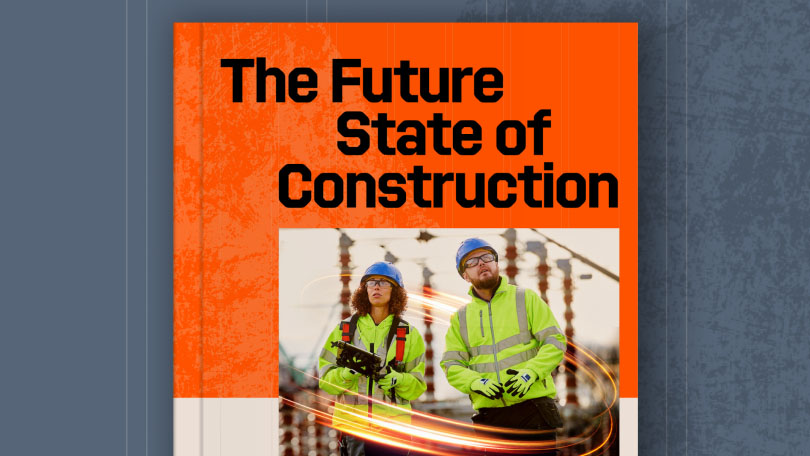— 7 min read
Keeping Everyone Informed: Sharing Project Information to Avoid Mistakes
Last Updated Aug 28, 2025
Rafal Kostylo
Senior Construction Manager
Rafal Kostylo is a highly skilled Construction and Project Manager with over 25 years of extensive experience and a Master’s degree in Civil Engineering. His expertise encompasses managing complex construction projects, including data centers, residential buildings, and hotels, ensuring exceptional quality and compliance with industry standards. Rafal specializes in construction management for projects valued at over £150 million, particularly in the data center sector. Known for his sharp attention to detail and exceptional problem-solving abilities, he fosters collaboration among diverse teams for successful delivery. His leadership philosophy focuses on empowering team members through the provision of essential management and communication tools, along with a commitment to high performance. Throughout his career, Rafal has successfully managed project schedules, budgets, client briefs, and changes while engaging with stakeholders to deliver projects on time and within budget. His proactive approach to identifying risks and resolving issues further underscores his commitment to successful project delivery. Rafal is proficient in designing and implementing realistic and effective processes through Project Execution Plans and enhanced communication, resulting in the elimination of significant delays and cost increases.
Last Updated Aug 28, 2025

Construction projects generate a huge amount of data and information that the teams on site and in the office need to stay on top of to keep the project running smoothly. Examples of this information include design changes, variations, deliveries and project status, to name just a few. Keeping everyone informed about the key changes or updates is a challenge, and one that must be tackled daily. If people aren’t kept up to date, it can lead to mistakes, reworks and delays — all of which affect the bottom line and can result in subcontractor claims.
Table of contents
Who’s in charge of keeping everyone informed?
There are three key roles that are responsible for ensuring that teams are kept up to date with the latest information. These are:
- The project manager
- The quality assurance (QA) manager
- The design manager
The people in these three roles must collaborate to set the process for sharing information, as well as the methods they will use to make sure that everyone on the project is on board with those processes and procedures.
Everything starts with the Project Execution Plan. Part of this plan outlines how the communication process, document control process, design management and filing system will work. It should detail how to create the link between electronically stored documents and physical documents. It will also include details for how to train staff — educating them on the QA and filing processes, for example — and processes for technical submissions, requests for information (RFIs), drawings and revisions.
It's good practice to start having quality meetings early on, as well as meetings between the main contractor and subcontractors, with the document controllers and managers also present, to set them up for successful collaboration. The document manager will usually be the individual responsible for helping subcontractors to comply with information sharing processes, so it’s vital that the project manager ensures they receive sufficient training.
The key is that you have a competent and well-trained document controller. Without one, issues with information sharing and documentation can drag on for weeks or even months, which can cause significant delays.
Rafal Kostylo
Senior Construction Manager
Freelance
The role of the design manager should also not be underestimated here. The design manager is ultimately responsible for tracking all design changes and critical submissions within the information platform. An experienced design manager will work closely with the document controller and project manager. The project manager should also encourage and enable close collaboration between the design manager, document controller and QA manager.
The QA manager works closely with the document controller to ensure the subcontractors are proficient with submittals. They may also work with the document controller on maintaining as-built documentation.
Maintaining Momentum When Design Changes Arise
It’s not unusual for designs to change late into projects. In fact, designs often move for the entire lifecycle of the project. What’s important is that these changes are managed and communicated effectively so that teams don’t work from the wrong version of a drawing, specification or any other document.
There are many ways that changes can be raised. It could be through a design meeting, when subcontractors raise issues about, for example, clashes or other problems they identify in a drawing or during installation. It could also happen on site, with a team member raising a change on a site monitoring application. If you have a good document controller, they will action this quickly and raise the change process on a communication platform like Procore or similar so that there is more visibility.
To keep things moving swiftly, and to avoid a situation where rework is needed — including abortive work — the project manager needs to instil the importance of checking drawings within the team before going forward with an updated or revised activity. If there have been updates to the design, it’s critical that the teams are working from the latest drawing. Cultivating a team mentality of double-checking drawings is the best way to avoid errors. The key is to always check the latest information on the communication platform and, if required, confirm it with the design manager.
Alongside encouraging these habits, it’s also best practice to make sure you discuss the changes in team meetings, such as the daily briefings for live tasks, weekly design meetings, progress meetings or even in one-off workshops where you get all the relevant people into a room to discuss the changes. It is critical that any changes or updates are always communicated to the people involved in the activity that is subject to change.
How a Communication Platform Supports Better Information Sharing
Without a good communication platform, it’s difficult to maintain a well-managed project — and almost impossible for large projects. Construction management platforms with communication tools need to be part of the process, because they act as a repository for information to be properly managed and controlled so that everybody has access to updates, changes and information.
I’ve used Procore on site for our communication and construction management during the fast-tracked construction of a data centre where I had to expedite the schedule by four months, and the project was very successful. I’ve noticed that Procore is much easier, simpler and more intuitive than other platforms.
Rafal Kostylo
Senior Construction Manager
Freelance
We’ve already discussed the importance of checking for updated drawings. The construction management platform is the tool that enables workers on site to do this quickly and easily, without having to ask somebody else to do it for them. Ideally, everybody should have mobile access to the platform through a device to enable them to efficiently check information, and to receive notifications of updates or changes.
Construction management platforms are excellent for keeping all parties on a construction job up to date with the latest developments, drawings and decisions about a project. They help to give everybody the access to the documents and information that they need, and since they access the platform from mobile devices, they help site teams to stay in the loop while they work. Mobile access also means that workers can check their drawings — including making sure that they are using the right version — so that they don’t make mistakes on site. These platforms also help construction companies with their sustainability goals, as they eliminate the need for excessive printing.
It's important that the document controller is trained in the communication platform to a high standard, otherwise there is a risk that they could become a blocker to the information sharing process, instead of an enabler.
Communication platforms are really useful tools. However, if there are complicated, lengthy processes, or the document controller is not proficient in the platform, they can become the obstacle to achieving the project timeline.
Rafal Kostylo
Senior Construction Manager
Freelance
Bonus Tip from a Previous Project
Delays are an aspect of construction that can sometimes feel inevitable, but they can cause a lot of problems. Negative effects include a disrupted critical path and claims or penalties at the end of the project. Here is a great example of a strategy that can help you to avoid this:
While constructing a data centre for leading developer Vantage, I identified inconsistencies in the information flow around critical-equipment final design and the application of lessons learned from previous projects. As the Senior Project Manager on the client side, I chaired a series of design workshops to support the main contractor and to facilitate the contractor-and-consultant weekly design meeting.
During the workshops I reviewed the lessons-learned tracker with the relevant equipment manufacturers and resolved any queries between the main contractor and those manufacturers, making sure the appropriate consultants were present.
After each workshop I issued minutes to both the general contractor and the manufacturers and asked that any outstanding queries be logged in Procore as RFIs. At the weekly design meetings I confirmed that all parties had raised the necessary RFIs and asked the document controller to generate an RFI tracker from Procore. We then set priorities, and the design manager assigned Procore timelines for each query so that answers supported the critical path and the manufacturing-and-delivery schedule.
This process streamlined information flow, eliminated unnecessary delays, and ultimately accelerated construction.
Rafal Kostylo
Senior Construction Manager
Freelance
Documenting the timelines and milestones in which information needs to be shared is a great way to maintain a thorough approach to keeping everyone informed. It holds everyone accountable and minimises the chances of delays related to sharing information.
Categories:
Written by
Rafal Kostylo
Senior Construction Manager | Freelance
Rafal Kostylo is a highly skilled Construction and Project Manager with over 25 years of extensive experience and a Master’s degree in Civil Engineering. His expertise encompasses managing complex construction projects, including data centers, residential buildings, and hotels, ensuring exceptional quality and compliance with industry standards. Rafal specializes in construction management for projects valued at over £150 million, particularly in the data center sector. Known for his sharp attention to detail and exceptional problem-solving abilities, he fosters collaboration among diverse teams for successful delivery. His leadership philosophy focuses on empowering team members through the provision of essential management and communication tools, along with a commitment to high performance. Throughout his career, Rafal has successfully managed project schedules, budgets, client briefs, and changes while engaging with stakeholders to deliver projects on time and within budget. His proactive approach to identifying risks and resolving issues further underscores his commitment to successful project delivery. Rafal is proficient in designing and implementing realistic and effective processes through Project Execution Plans and enhanced communication, resulting in the elimination of significant delays and cost increases.
View profileExplore more helpful resources

Why Construction Needs to Invest in Digital Twins
A digital twin in construction is an exact virtual representation of a building that continuously pulls in live data about it to reflect its real-time status. It’s more than just...

UK Construction Accounting: An Introduction
Construction companies face difficult financial choices, such as bidding on one project over another, selecting financing for materials or plant, or setting a project’s profit margin. Construction is a notoriously...

Facilitating Effective Communication and Collaboration Across Construction Teams
In construction, communication is more than a nice-to-have – it’s the scaffolding that holds everything together. Without it, even the most well-designed projects can wobble under the weight of confusion,...

Practical BIM Clash Detection for Constructible Coordination
On a simple build – say, a two-storey house – coordinating what needs to be built where and when is fairly straightforward. However, as a project grows in scale, so...
